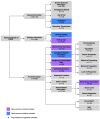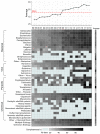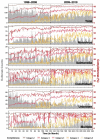Evaluating Completeness of Foodborne Outbreak Reporting in the United States, 1998-2019
- PMID: 35270590
- PMCID: PMC8910621
- DOI: 10.3390/ijerph19052898
Evaluating Completeness of Foodborne Outbreak Reporting in the United States, 1998-2019
Abstract
Public health agencies routinely collect time-referenced records to describe and compare foodborne outbreak characteristics. Few studies provide comprehensive metadata to inform researchers of data limitations prior to conducting statistical modeling. We described the completeness of 103 variables for 22,792 outbreaks publicly reported by the United States Centers for Disease Control and Prevention’s (US CDC’s) electronic Foodborne Outbreak Reporting System (eFORS) and National Outbreak Reporting System (NORS). We compared monthly trends of completeness during eFORS (1998−2008) and NORS (2009−2019) reporting periods using segmented time series analyses adjusted for seasonality. We quantified the overall, annual, and monthly completeness as the percentage of outbreaks with blank records per our study period, calendar year, and study month, respectively. We found that outbreaks of unknown genus (n = 7401), Norovirus (n = 6414), Salmonella (n = 2872), Clostridium (n = 944), and multiple genera (n = 779) accounted for 80.77% of all outbreaks. However, crude completeness ranged from 46.06% to 60.19% across the 103 variables assessed. Variables with the lowest crude completeness (ranging 3.32−6.98%) included pathogen, specimen etiological testing, and secondary transmission traceback information. Variables with low (<35%) average monthly completeness during eFORS increased by 0.33−0.40%/month after transitioning to NORS, most likely due to the expansion of surveillance capacity and coverage within the new reporting system. Examining completeness metrics in outbreak surveillance systems provides essential information on the availability of data for public reuse. These metadata offer important insights for public health statisticians and modelers to precisely monitor and track the geographic spread, event duration, and illness intensity of foodborne outbreaks.
Keywords: National Outbreak Reporting System (NORS); data completeness; electronic Foodborne Outbreak Reporting System (eFORS); foodborne outbreaks; precision public health; time series analyses.
Conflict of interest statement
The authors declare no conflict of interest.
Figures



Similar articles
-
Surveillance for foodborne disease outbreaks - United States, 1998-2008.MMWR Surveill Summ. 2013 Jun 28;62(2):1-34. MMWR Surveill Summ. 2013. PMID: 23804024
-
Analyses of the eFORS (Electronic Foodborne Outbreak Reporting System) surveillance data (2000-2004) in school settings.J Environ Health. 2010 Mar;72(7):8-13. J Environ Health. 2010. PMID: 20235403
-
Outbreaks of Acute Gastroenteritis Transmitted by Person-to-Person Contact, Environmental Contamination, and Unknown Modes of Transmission--United States, 2009-2013.MMWR Surveill Summ. 2015 Dec 11;64(12):1-16. doi: 10.15585/mmwr.mm6412a1. MMWR Surveill Summ. 2015. PMID: 26656915
-
Foodborne Illness Outbreaks Reported to National Surveillance, United States, 2009-2018.Emerg Infect Dis. 2022 Jun;28(6):1117-1127. doi: 10.3201/eid2806.211555. Emerg Infect Dis. 2022. PMID: 35608555 Free PMC article. Review.
-
Epidemiology of foodborne diseases: a worldwide review.World Health Stat Q. 1997;50(1-2):30-50. World Health Stat Q. 1997. PMID: 9282385 Review.
Cited by
-
Development and Evaluation of a Next-Generation Sequencing Panel for the Multiple Detection and Identification of Pathogens in Fermented Foods.J Microbiol Biotechnol. 2023 Jan 28;33(1):83-95. doi: 10.4014/jmb.2211.11009. Epub 2022 Nov 16. J Microbiol Biotechnol. 2023. PMID: 36457187 Free PMC article.
-
Trends in Burdens of Disease by Transmission Source (USA, 2005-2020) and Hazard Identification for Foods: Focus on Milkborne Disease.J Epidemiol Glob Health. 2024 Sep;14(3):787-816. doi: 10.1007/s44197-024-00216-6. Epub 2024 Mar 28. J Epidemiol Glob Health. 2024. PMID: 38546802 Free PMC article.
-
Gold Nanoparticle-Based Colorimetric Biosensing for Foodborne Pathogen Detection.Foods. 2023 Dec 27;13(1):95. doi: 10.3390/foods13010095. Foods. 2023. PMID: 38201122 Free PMC article. Review.
-
Assessment of the prevalence, serotype, and antibiotic resistance pattern of Salmonella enterica in integrated farming systems in the Maryland-DC area.Front Microbiol. 2023 Aug 10;14:1240458. doi: 10.3389/fmicb.2023.1240458. eCollection 2023. Front Microbiol. 2023. PMID: 37637118 Free PMC article.
-
Exploring Risk Factors of Recall-Associated Foodborne Disease Outbreaks in the United States, 2009-2019.Int J Environ Res Public Health. 2022 Apr 19;19(9):4947. doi: 10.3390/ijerph19094947. Int J Environ Res Public Health. 2022. PMID: 35564342 Free PMC article.
References
-
- Centers for Disease Control and Prevention (CDC) Foodborne Illnesses and Germs. [(accessed on 30 November 2021)]; Available online: http://www.cdc.gov/foodsafety/foodborne-germs.html.
-
- United States Food and Drug Association (FDA) Most Common Foodborne Illnesses. United States Department of Health and Human Services; Washington, DC, USA: [(accessed on 1 September 2021)]. Available online: https://www.fda.gov/files/food/published/Most-Common-Foodborne-Illnesses....
-
- United States Food and Drug Association (FDA) United States Department of Health and Human Services; [(accessed on 1 September 2021)]. What You Need to Know About Foodborne Illnesses. Available online: https://www.fda.gov/food/consumers/what-you-need-know-about-foodborne-il....
-
- Centers for Disease Control and Prevention (CDC) Office of Public Health Scientific Services (OPHSS) Center for Surveillance, Epidemiology, and Laboratory Services (CSELS) Division of Health Informatics and Surveillance (DHIS) Surveillance Case Definitions for Current and Historical Conditions. [(accessed on 1 September 2021)]; National Notifiable Diseases Surveillance System (NNDSS) Available online: https://wwwn.cdc.gov/nndss/conditions/
Publication types
MeSH terms
LinkOut - more resources
Full Text Sources
Medical

